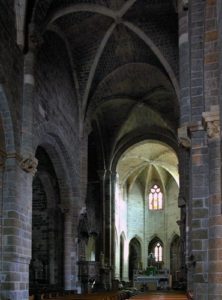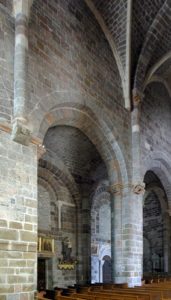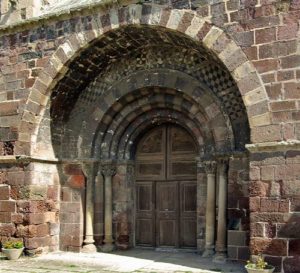The Abbey of St Théofrède (Chaffre) du Monastier was the largest Benedictine Monastery in the Velay area and is described as one of the finest examples of Romanesque architecture.
There was a small monastic community in the area from the 6thC. St Théofrède (St Chaffre) founded the monastery in the 7thC. Several churches were built here but all collapsed due to the instability of the site. Parts of the apse near the choir date from the 10thC. Most of the present building dates from the 11thC but there was a major restoration in the 15thC when part of the choir collapsed. The monastery was closed during the Revolution.
It is a huge building built from purple brown basalt. The top of the apse at the east end is newer and built from a much paler stone and has big flying buttresses. There are huge buttresses on the south side. The north side used to have the cloisters off it. These were destroyed during the Revolution and newer houses have been built along the north wall. The Marie was built along the line of the east side of the cloisters and maintains an architectural style with an arcade and round arches outside.
Steep steps lead up to the west end of the church. This has a central doorway set inside a huge carved archway with small round pillars. On either side are large blank round topped arches. Above is a large central round window set in an elaborately carved portico. There are small slit windows on either side. All have pillars supporting a round arch decorated with different coloured stones. There is a carved frieze under the eaves of the roof.
Entry is through the south door set under a carved round arch. Immediately opposite is the massive wooden organ with inlays of different coloured wood. This dates from 1518 and is one of the oldest organs in Europe. At the top are badges of St Théofrède and Gaspard de Tournon who was Abbot when the organ was installed.
The nave is built from purple basalt and has massive pillars with carved capitals. Antlantes imperturbables holding up the top with their hands feature widely. Above is a ribbed vaulted ceiling. The north wall has multiple round arches on the walls but no windows as they were filled in with stone when the houses were built along the outside of the wall. There is a big wooden pulpit with the four evangelists carved round the sides and Christ teaching on the back wall. Above is a carved spire supported by angels. On the arch opposite is a crucifix.
There is a massive baroque altar in the south transept which is painted white. On the base is a M monogram on blue surrounded by gilt decoration. There is a statue of the Virgin on the host box which is surrounded by metal flowers which now have light bulbs in them. The two big candlesticks have more metal flowers and light bulbs, all lit. On either side are white barleycorn twist pillars with carved gilt grapes winding up them. There is a M monogram at the top of the retable and a modern stained glass window above with a picture of the Virgin. On the south chancel transept is another statue of Mary surrounded by more light bulbs.
There is a splendid high altar of white marble inlaid with coloured marble. There are gilt angels on either side of the host box, which has an image of the Good Shepherd on the door and a cross on top. Pillars support an open cupola above it. On either side are very tall candlesticks. There are old wooden choir stalls round the walls of the chancel.
There is a narrow ambulatory round the back of the high altar with apses off containing altars or statues. From the south, there is a plain wooden altar and retable with a painting of St Ann teaching the young Mary with a cherub above.
The next apse has a carved retable and an elaborately carved ceiling with panels with carved heads, animals, flowers and badges.
The next apse has a Statue of St Fortuna, with a Statue of St Francis of Assisi in the next one. In the next apse is a Statue of Jesus with a red heart on his chest. On the wall between this and the next niche is a memorial to the dead of World War One.
The apse on the far north side has a very unloved wooden altar with a very dark painting of St Martin above it.
The north transept has a baroque altar painted in pale beige. The retable has barleycorn twist pillars with gilt grapes with a statue of Joseph on the host box. On either side are angels holding candlesticks but no light bulbs. On the wall is a stained glass window of Joseph with the boy Jesus.
There is a statue of Joan of Arc on the north transept pillar . She has a few lit light bulbs on candlesticks.
There are two small green and brown reliquary boxes on the chancel transept pillars.
A door on the north wall leads into the Sacristy which houses the treasury, but it was shut when we visited.
The town itself is run down and has seen better days. The only reason to visit is for the Abbey which s a good example of Romanesque architecture with some splendid carved capitals.










